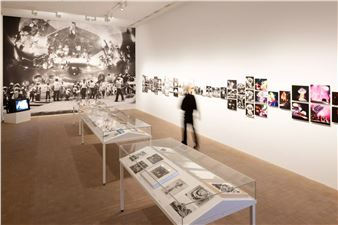To Watch the War: In Solidarity
BAK, basis voor actuele kunst, Utrecht invites you to visit the exhibition To Watch the War, in Solidarity with works by artists Jelena ´łłÜ°ů±đš˛ą, Aernout Mik, and Rabih MrouĂ©.
This impromptu presentation is a part of a long-term series under the same title, related to the image forum To Watch the War: The Moving Image Amidst the Invasion of Ukraine (2014–2023) at BAK, taking place between 9 September and 29 October 2023. It mobilizes artworks from BAK’s former and future archives with the aim of appealing—with and through art—to the vital sense of solidarity with people and other-than-human subjects exposed to the war in Ukraine and the wars the world over. Driven by the concern about the lasting state of warfare that engulfs the world along with the global rise of fascist politics and the growing lust for the hegemony of forever-empires, these exhibitions want to remind us that our awareness of the current conditions and our will toward a better world must not waver.
Much like the films by Ukraine-based artists in the image forum at BAK, the artworks by ´łłÜ°ů±đš˛ą, Mik, and MrouĂ© ponder on the relationship between image production and contemporary warfare. Equally importantly, they inquire about the role of art and artists in relation to the disturbing recurrence of wars in our time, as well as in relation to war in its expanded sense: as an infrastructure of racial capitalism at the throughline of slavery, colonialism, imperialism, and oppression of all kinds.
´łłÜ°ů±đš˛ąâ€™s film Aphasia (Act Three) – A Kid from the Neighborhood (2019) addresses collective silence on the enduring historico-political crime complex at the intersection of Belgian colonialism, Austrian anti-Semitism, and the wars in former Yugoslavia. The work centers on an infamous photograph from the war in Bosnia in which a soldier is seen kicking the head of a dead Muslim woman killed by Serbian paramilitaries. Never shown, the photograph is animated through speech and choreography, indirectly considering the role of art in relation to war as part of forensic practice aimed at truth and justice.

Recommended for you
BAK, basis voor actuele kunst, Utrecht invites you to visit the exhibition To Watch the War, in Solidarity with works by artists Jelena ´łłÜ°ů±đš˛ą, Aernout Mik, and Rabih MrouĂ©.
This impromptu presentation is a part of a long-term series under the same title, related to the image forum To Watch the War: The Moving Image Amidst the Invasion of Ukraine (2014–2023) at BAK, taking place between 9 September and 29 October 2023. It mobilizes artworks from BAK’s former and future archives with the aim of appealing—with and through art—to the vital sense of solidarity with people and other-than-human subjects exposed to the war in Ukraine and the wars the world over. Driven by the concern about the lasting state of warfare that engulfs the world along with the global rise of fascist politics and the growing lust for the hegemony of forever-empires, these exhibitions want to remind us that our awareness of the current conditions and our will toward a better world must not waver.
Much like the films by Ukraine-based artists in the image forum at BAK, the artworks by ´łłÜ°ů±đš˛ą, Mik, and MrouĂ© ponder on the relationship between image production and contemporary warfare. Equally importantly, they inquire about the role of art and artists in relation to the disturbing recurrence of wars in our time, as well as in relation to war in its expanded sense: as an infrastructure of racial capitalism at the throughline of slavery, colonialism, imperialism, and oppression of all kinds.
´łłÜ°ů±đš˛ąâ€™s film Aphasia (Act Three) – A Kid from the Neighborhood (2019) addresses collective silence on the enduring historico-political crime complex at the intersection of Belgian colonialism, Austrian anti-Semitism, and the wars in former Yugoslavia. The work centers on an infamous photograph from the war in Bosnia in which a soldier is seen kicking the head of a dead Muslim woman killed by Serbian paramilitaries. Never shown, the photograph is animated through speech and choreography, indirectly considering the role of art in relation to war as part of forensic practice aimed at truth and justice.















